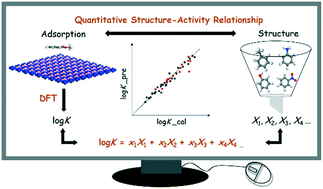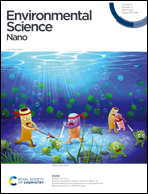Predicting the adsorption of organic pollutants on boron nitride nanosheets via in silico techniques: DFT computations and QSAR modeling†
Abstract
Investigating the adsorption of organic pollutants onto boron nitride nanosheets is crucial for designing novel boron nitride adsorbents so as to remove pollutants from the environment. In this study, we performed density functional theory (DFT) computations to investigate the adsorption of 28 aromatic compounds onto boron nitride nanosheets, and developed four quantitative structure–activity relationship (QSAR) models for predicting the logarithm of the adsorption equilibrium constant (log K) values of organic pollutants adsorbed onto boron nitride nanosheets in both gaseous and aqueous environments. The DFT-predicted adsorption energies showed that boron nitride nanosheets exhibit stronger adsorption capability than graphene. Our QSAR analyses revealed that van der Waals interactions play dominant roles in gaseous adsorption, while van der Waals and hydrophobic interactions are the main driving forces in aqueous adsorption. This work demonstrates that in silico QSAR models can serve as efficient tools for high-throughput prediction of log K values for organic pollutants adsorbed onto boron nitride nanomaterials.



 Please wait while we load your content...
Please wait while we load your content...
